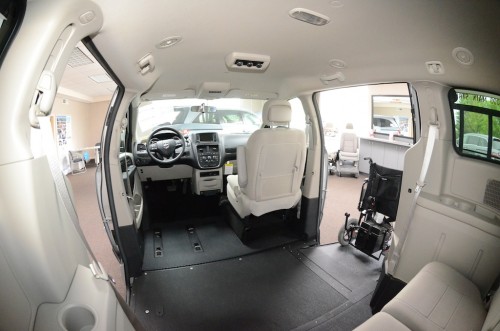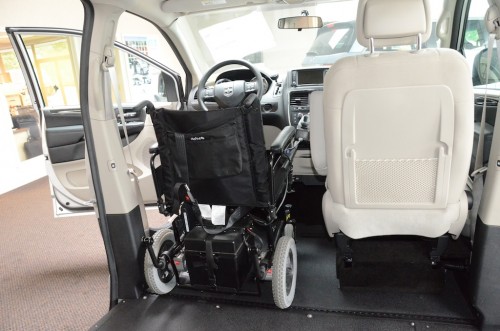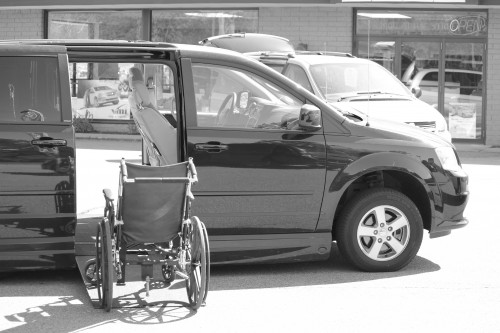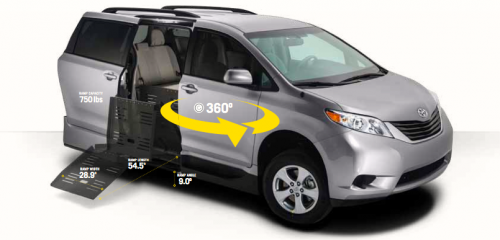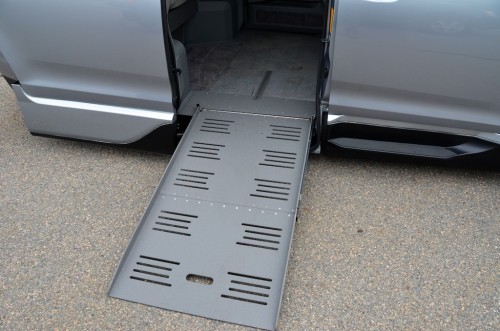One of the most significant decisions you will make in the purchase of a wheelchair van is whether to put the wheelchair access ramp on the side or in the rear of the vehicle. Both are great options and like anything else, there are pros and cons to each. Your own personal preferences and the environment in which you travel and live will have the greatest impact on your choice between the two. In addition, budget may also prove to be a consideration in your decision making process as well.
Rear-Entry Wheelchair Vans
To make a minivan rear-entry accessible, the mobility converter cuts out the center of the floor, 30” wide and 10” deep, from the rear bumper up to either the back of the middle seat or the back of the front seat. A new lowered section is then welded in and finished with the rest of the conversion.
Advantages of Rear-Entry Vans
- Less Expensive: A rear-entry conversion method affects a smaller area of the vehicle and has less impact on the structural integrity of the minivan. For these reasons, rear-entry conversions are significantly less expensive than similar side-entry conversions.
- Depending on the conversions it may or may not have better Ground Clearance: Although the floor is lowered with a rear-entry vehicle, there are no modifications done to the sides. In addition, a rear-entry conversion is raised higher in the back. Therefore, greater ground clearance results in more space than on a side-entry van.
- Ease of Entry but not Exit: When you enter a rear-entry minivan, there is no turning around (there isn’t enough room) to get the wheelchair into the traveling position. All that is needed is for a person to simply move up as far as required to get into their wheelchair securement device. The down side is you have to back out and down the ramp. For individuals with exceptionally long wheelchairs or conditions requiring extended legs or tilted backs, this is especially valuable.
- Tight Parking: A rear entry wheelchair minivan maybe able to park in regular, non-accessible parking spaces and garages if required. With the wheelchair ramp in the rear, no extra side room is required. But now you have to exit the vehicle into traffic. A rear-entry vehicle is also helpful in situations where double parking is required for loading and unloading.
Disadvantages of Rear-Entry Vans
- Limited Parallel Parking: The rear-entry vehicle makes loading or unloading wheelchair passengers while parallel-parked impossible. Parking on the end of the street or loading or unloading on the street before moving into a parking spot would be the only feasible options.
- Wheelchair Pilot or Co-Pilot Seating Unavailable: Rear-entry accessibility does not allow the person operating the wheelchair to sit in the pilot or co-pilot seat because the floor is only lower to just behind the front seats. Instead they must sit in the second or third row of the van unless they are able to transfer from their wheelchair into the second row to the front passenger seat.
Side-Entry Wheelchair Vans
To make a minivan side-entry accessible, the mobility converter lowers the floor between 10-15” from the rear bench seat all the way forward, referred to as a firewall, or in some cases to just behind the front seats. Therefore, with a side-entry van, a wheelchair operator can move into the pilot or co-pilot position more easily.
Advantages of Side-Entry Vans
- Parallel Parking: The side-entry accessible van is not affected by parallel parking. Passengers in wheelchairs can still get in and out of the vehicle parked parallel to a curb, which is helpful for people who live in the city or a neighborhood where parking lots are not available.
- Pilot and/or Co-Pilot Capability/Compatibility: The side-entry allows the wheelchair operator to drive or ride in the passenger seat. Pilot and co-pilot compatibility is an important feature for couples who wish to ride in the front together or for families with wheelchair operators that drive.
Disadvantages of Side-Entry Vans
- Inside Space Limited: Space is limited for large really long wheelchairs.
VMi New England consultants can help you access your needs and determine if a side-entry or rear-entry van is suitable for you.

